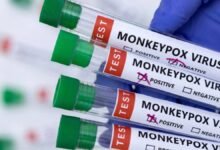Testing tears could help in ascertaining Coronavirus presence

Coronavirus, which caused the Covid-19 pandemic, can be detected from tears, researchers have figured out.
Three years after its unwarranted entry that shook the globe, more findings about coronavirus are pouring in. The virus that caused the Covid-19 pandemic can be detected from tears, researchers have figured out.
Scientists at the University of São Paulo (USP) in Brazil now claim tears from swabbing can detect the virus that wreaked havoc and induced worldwide shutdowns. Scientists made this finding after analysing samples from COVID-19 patients admitted at Hospital for Rehabilitation of Craniofacial Anomalies.
Testing tears could prove virus presence
They said the coronavirus, known as SARS-CoV-2, which causes the illness, was detected in 18.2 per cent of the collected samples. This is a pointer that the method may be applicable in detecting the virus and may be deployed in future to replace nasopharyngeal swabbing.
Nasopharyngeal swabbing involves inserting a long swab through the nose to collect secretion samples from the nasopharynx – the upper part of the throat behind the nose.
Such samples are analyzed to figure out the presence of viruses, bacteria, or other pathogens that trigger respiratory infections. Collecting samples through tears would reduce the risk of infection spreading to health workers.
The findings were published in an article in the Journal of Clinical Medicine in November last. The nasopharyngeal swabbing procedure is considered unpleasant to patients and health workers.
The higher the viral load is, the probability of finding the virus also rises, as per the study. The samples were analyzed between July and November 2021.
The initial aim of the research was to develop an easier method of diagnostic test which would cause minimum discomfort to those with symptoms and patients.
Nasal, nasopharyngeal swabbing irritating for patients
Scientists said nasal and nasopharyngeal swabbing is not only irritating for patients but also mostly done incorrectly. It was in this context that after much thought, the scientists figured out that samples from tears could be used for virus detection.
They acknowledged that a limitation of the study was that it is not known whether the number of tears may influence results. Researchers also deployed the Schirmer Strip Test Technique, wherein a filter paper strip is inserted on the lower eyelid. The Schirmer strip test is normally conducted to ascertain if the eye produces enough quantity of tears.
In a study published in Experimental Biology and Medicine in July 2021, State University of Campinas’s School of Medical Sciences, Sao Paulo, researchers also reported SARS-CoV-2 detection in tear samples from 8.43 per cent of a total of 83 patients.
Researchers are now also focussing on other detecting other viral diseases by means of conducting various tests in the eyes. The idea behind such research is to improve the quality of life of patients.







